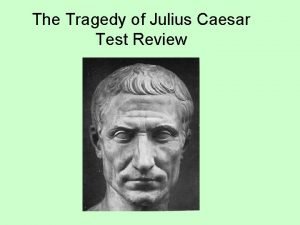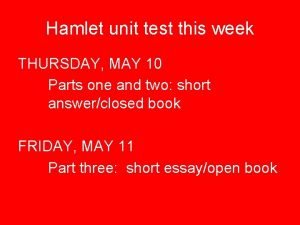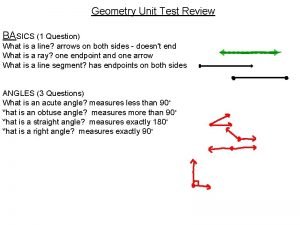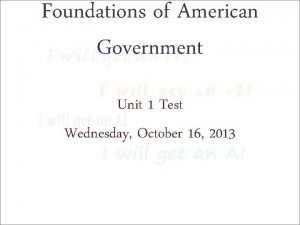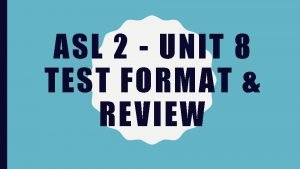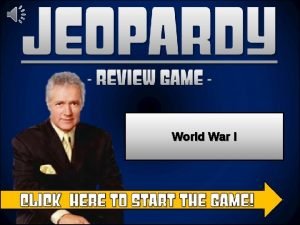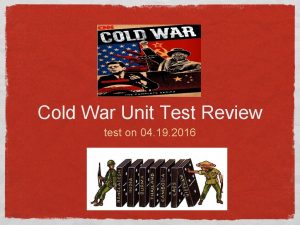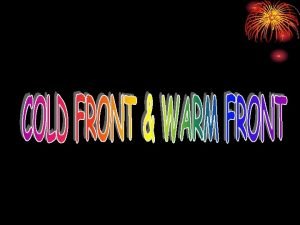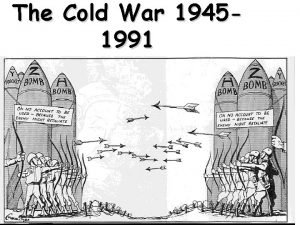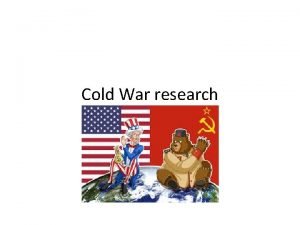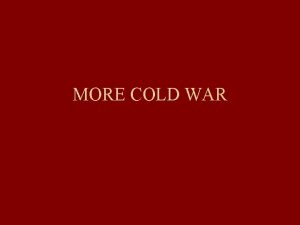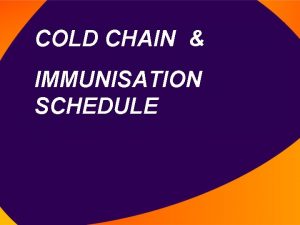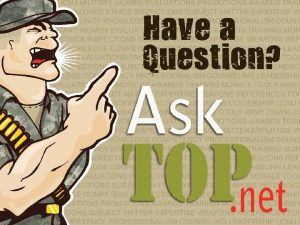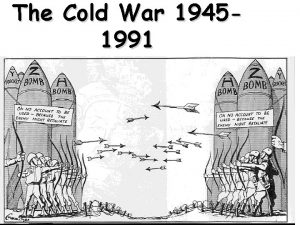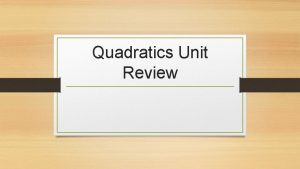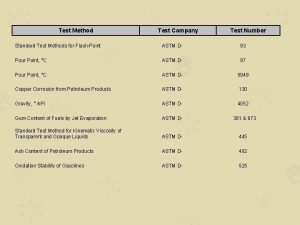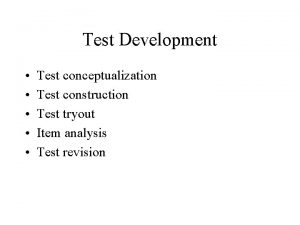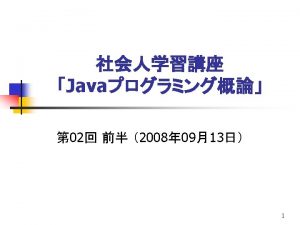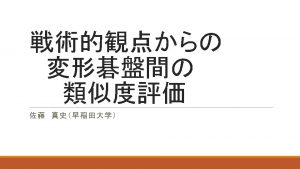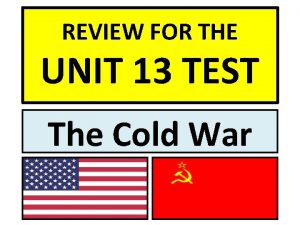REVIEW FOR THE UNIT 13 TEST The Cold



























































- Slides: 59

REVIEW FOR THE UNIT 13 TEST The Cold War

REVIEW FOR THE UNIT 13 TEST INSTRUCTIONS: Go through the slides and answer each question in the packet; the slide numbers are listed for each question

After WWII, the United States and the Soviet Union were the world’s two “superpowers” The “Cold War” was the rivalry between the US and the USSR (or Soviet Union) where they competed militarily and economically

A “hot” war is a war fought the usual way: with weapons and soldiers; because of the threat of nuclear destruction, the US and USSR did not fight a “hot” war Instead, the USA and USSR engaged in a “cold” war, doing everything just short of openly fighting to hurt the enemy

WHAT IS “IDEOLOGY”? An IDEOLOGY is a philosophy, or a way of thinking Ideologies of nations can be based on politics, economics, or religion

What were the major ideologies of the USA and the USSR? The Cold War was an era of competing ideologies: the USA promoted democracy and capitalism while the USSR believed in totalitarianism and communism

President Truman created a foreign policy called containment to stop Soviet influence and stop the spread of communism; containment was the U. S. ’s primary goal in the Cold War

Stalin failed to keep his promise of allowing free elections in Eastern Europe after WWII; this was the main cause of distrust between the US and the USSR after the war

The “Marshall Plan” had the goal of stopping the spread of communism by providing money to war-torn European nations (making them economically strong enough to prevent communism from taking hold) M=

The United States formed the North Atlantic Treaty Organization (NATO), a military alliance that had the goal of resisting Soviet aggression and protecting democratic nations

Europe was divided by the figurative “iron curtain” that separated democratic/capitalist Western Europe from communist/totalitarian Eastern Europe “IRON CURTAIN”: nickname for the boundary between the two sides WESTERN EUROPE: Capitalism and Democracy EASTERN EUROPE: Communism and Totalitarianism

The countries directly east of the boundary in the middle were called “Soviet satellite nations” Satellites: East Germany, Poland, Czechoslovakia, Hungary, Romania, Bulgaria; these countries served as a “buffer zone” between the USSR and the West, which was a major victory for the USSR in the Cold War

The best example of the success of America’s “containment” policy was preventing communism from spreading into Greece and Turkey by giving them military aid

ARMS RACE: The United States were the first to develop the hydrogen bomb, and the Soviet Union tested their own hydrogen bomb soon after that

Mutually Assured Destruction: If nuclear war happened, it would be likely that both sides would be destroyed, along with the rest of the world; this is what made the US and USSR hesitant to go to war

This map shows that the US and USSR had enough nuclear missiles to destroy each other (Mutually Assured Destruction)

The USA was afraid of a “domino theory” in which communist nations make their neighbors fall to communism; this was the reason for U. S. intervention in Korea and Vietnam during the Cold War

Outcome of the Korean War: the USA successfully stopped communism from spreading into South Korea and showed that it was willing to fight to contain communism

In the 1950 s, President Eisenhower escalated the Cold War by using “brinkmanship”: threatening to use nuclear weapons and willingness to go to the brink of war

If the USSR attacked a NATO member, the U. S. would attack every major Soviet city and military target; this policy was called “massive retaliation”

China had a civil war before and after WWII; Mao Zedong was the leader of the Communist faction

Mao’s Communist Party gained popularity among poor peasants by dividing land among the peasants, while the Nationalists ignored their problems

In 1949, the Communists won the Civil War and Mao created the Peoples’ Republic of China

Mao’s “Great Leap Forward” Mao began a program called the “Great Leap Forward”; similar to Stalin’s “Five Year Plans”, it had the goal of improving agricultural and industrial production

The goal of the Cultural Revolution was to reinforce Communist values in China and attack traditional Chinese ideas

Mao distributed to all Chinese citizens the “Little Red Book, ” a book of his quotes that reinforced what was acceptable for Chinese communists

Part of the “Cultural Revolution” was closing schools and universities, burning books; the Communists also humiliated, beat, arrested, and killed people who were critics of Mao’s programs

Much like the “Reign of Terror” during the French Revolution, the Cultural Revolution used violence to eliminate or silence opponents and critics

BERLIN: A DIVIDED CITY IN HOSTILE TERRITORY Communist East Berlin Democratic West Berlin The German city of Berlin became divided after WWII into a communist part and a democratic part

Much like Berlin in Germany, Vietnam had become divided: North Vietnam was communist, while South Vietnam was democratic

When communist leader Ho Chi Minh gained independence for Vietnam, the USA feared communism spreading in Southeast Asia The U. S. sent troops to Vietnam to stop the spread of communism, just like they had done in Korea

The American military used bombing raids, herbicides, and searchand-destroy missions to fight the Vietcong

CUBA Much like Ho Chi Minh had done in Vietnam, Fidel Castro became the leader of a communist government in Cuba

In 1957, the USSR launched Sputnik, the first satellite in space Sputnik shocked the U. S. , which then encouraged Americans to focus on math, science, and technology education

The Berlin Wall was built by the communists to prevent East Germans from moving into the democratic Western part of Berlin

The Soviets were winning the “Space Race”, which led to President Kennedy committing the U. S. to being the first to land on the Moon In 1969, Apollo 11 landed U. S. astronauts on the moon

During the Cold War, the USA and USSR created intelligence agencies, the CIA and KGB, in order to carry out covert operations (spying, espionage, sabotage, assassinations)

In the 1970 s, President Nixon’s policy of détente (easing Cold War tensions) replaced the policy of brinkmanship (always willing to go to the edge of war)

In 1972, Nixon became the first U. S. president to visit China and to recognize communists as the legitimate government of China; this opened up American. Chinese relations

The USA and USSR signed the Strategic Arms Limitation Talks (SALT) which limited the number of ICBMs each nation could have

In response to the USSR moving nuclear missiles into Cuba, the US set up a naval blockade to prevent any more military supplies from getting to Cuba

After nearly going to war, the Soviets withdrew its nuclear missiles from Cuba

The USSR invaded Afghanistan to put down an anti-communist revolt and maintain a communist government there

Mikhail Gorbachev was different leader than Nikita Khrushchev: Gorbachev limited nuclear weapons while Khrushchev had built an enormous number of missiles and spread them to Cuba

One of Gorbachev’s reforms was “perestroika”, where the Soviet economy was changed by allowing some private ownership of business “Don't Be Afraid of Work. ”

Another reform by Gorbachev was glasnost (“openness”), which encouraged freedom of speech and allowed expression of new ideas “Be Bold, Comrade! Openness Is Our Strength!”

After Stalin’s death, new USSR leader Nikita Khrushchev began a series of reforms known as “de-Stalinization”, which included releasing political prisoners and relaxing censorship

Reagan’s most ambitious program was the Strategic Defense Initiative (SDI), called “Star Wars”: satellites with lasers designed to protect the U. S. from missile attacks

In November 1989, the Berlin Wall was torn down by celebrating East Berliners and West Berliners; this was the symbolic end of communism and the Cold War

From 1989 to 1991, nations of the USSR and Eastern Europe broke away from Soviet control; they had free elections and became democratic

The fall of the Berlin Wall and the break-up of the Soviet Union into fifteen separate nations signified the end of the Cold War THE FORMER SOVIET UNION: Russia, Estonia, Latvia, Lithuania, Belarus, Ukraine, Moldova, Armenia, Georgia, Azerbaijan, Turkmenistan, Uzbekistan, Tajikistan, Kyrgyzstan, Kazakhstan

A combination of internal problems and external pressures weakened the Soviet Union, much like what had happened to the Roman Empire back in 476 BCE SOVIET UNION ROMAN EMPIRE

WHAT CAUSED THE USSR TO BREAK UP AND COMMUNISM TO FALL? (1) Reagan’s strong stand against the communists and outspending the USSR in the arms race they could not afford (2) Gorbachev’s introduction of reforms made the flaws of communism as an economic system clear to the Russian people (3) Gorbachev allowing Eastern European countries to have a taste of democracy and freedom made those countries want more; they broke free of the Soviets’ influence

WHAT IS THE INDUSTRIAL REVOLUTION? “The Industrial Revolution” refers to the time period when there was a huge increase of machine-made goods in factories, which replaced work done by hand

IMPERIALISM IN ASIA The Dutch profited from rubber, tin, oil resources and cash-crop plantations The French profited from rice plantations as well as cash-crops (coffee, tea, spices)

The end result of the Russian Revolution of 1917 is that Vladimir Lenin and the Bolsheviks transformed Russia into the world’s first Communist nation, called the Soviet Union

The Treaty of Versailles ended World War I between Germany and the Allies; the Treaty led to the economic collapse of Germany by forcing the Germans to pay high war reparations

Fascist governments (like Mussolini’s and Hitler’s) and Communist governments (like Stalin’s) shared the belief that totalitarian dictators should rule their people

“IF YOU HAVE CORRECTLY ANSWERED ALL OF THE QUESTIONS ON YOUR REVIEW PACKET, YOU WILL BE READY FOR THE UNIT 13 TEST. ”
 Unit 6 review questions
Unit 6 review questions Unit test review algebra 2
Unit test review algebra 2 The cold war lesson 1
The cold war lesson 1 The tragedy of julius caesar unit test review
The tragedy of julius caesar unit test review Hamlet unit test
Hamlet unit test Unit test review geometry
Unit test review geometry Algebra 2 unit 2 test
Algebra 2 unit 2 test John proctor criticizes reverend parris for:
John proctor criticizes reverend parris for: Unit 1 test review us history
Unit 1 test review us history Foundations of american government unit 1 test review
Foundations of american government unit 1 test review Format asl
Format asl Romeo and juliet test
Romeo and juliet test Unit 6 test review algebra 1
Unit 6 test review algebra 1 Ww1 jeopardy
Ww1 jeopardy Right triangle trigonometry examples
Right triangle trigonometry examples Formuö
Formuö Typiska novell drag
Typiska novell drag Nationell inriktning för artificiell intelligens
Nationell inriktning för artificiell intelligens Ekologiskt fotavtryck
Ekologiskt fotavtryck Shingelfrisyren
Shingelfrisyren En lathund för arbete med kontinuitetshantering
En lathund för arbete med kontinuitetshantering Adressändring ideell förening
Adressändring ideell förening Tidbok för yrkesförare
Tidbok för yrkesförare A gastrica
A gastrica Förklara densitet för barn
Förklara densitet för barn Datorkunskap för nybörjare
Datorkunskap för nybörjare Stig kerman
Stig kerman Hur skriver man en tes
Hur skriver man en tes Magnetsjukhus
Magnetsjukhus Nyckelkompetenser för livslångt lärande
Nyckelkompetenser för livslångt lärande Påbyggnader för flakfordon
Påbyggnader för flakfordon Arkimedes princip formel
Arkimedes princip formel Publik sektor
Publik sektor Lyckans minut erik lindorm analys
Lyckans minut erik lindorm analys Presentera för publik crossboss
Presentera för publik crossboss Vad är ett minoritetsspråk
Vad är ett minoritetsspråk Bat mitza
Bat mitza Treserva lathund
Treserva lathund Mjälthilus
Mjälthilus Bästa kameran för astrofoto
Bästa kameran för astrofoto Centrum för kunskap och säkerhet
Centrum för kunskap och säkerhet Verifikationsplan
Verifikationsplan Bra mat för unga idrottare
Bra mat för unga idrottare Verktyg för automatisering av utbetalningar
Verktyg för automatisering av utbetalningar Rutin för avvikelsehantering
Rutin för avvikelsehantering Smärtskolan kunskap för livet
Smärtskolan kunskap för livet Ministerstyre för och nackdelar
Ministerstyre för och nackdelar Tack för att ni har lyssnat
Tack för att ni har lyssnat Referatmarkeringar
Referatmarkeringar Redogör för vad psykologi är
Redogör för vad psykologi är Borstål, egenskaper
Borstål, egenskaper Atmosfr
Atmosfr Borra hål för knoppar
Borra hål för knoppar Orubbliga rättigheter
Orubbliga rättigheter Formula varians
Formula varians Tack för att ni har lyssnat
Tack för att ni har lyssnat Rita perspektiv
Rita perspektiv Ledningssystem för verksamhetsinformation
Ledningssystem för verksamhetsinformation Tobinskatten för och nackdelar
Tobinskatten för och nackdelar Blomman för dagen drog
Blomman för dagen drog



